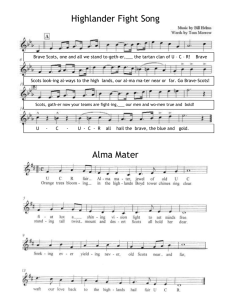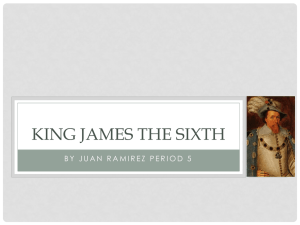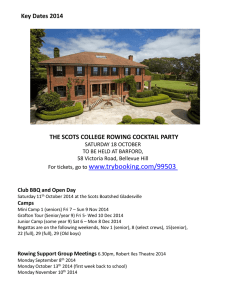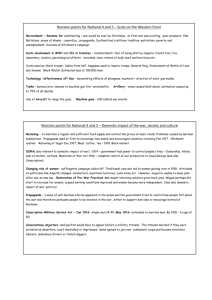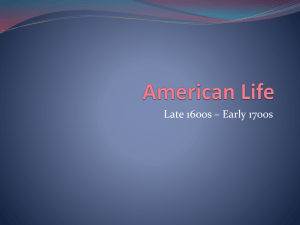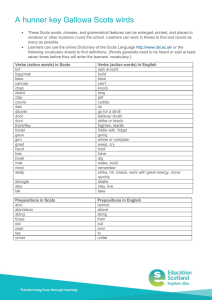Sixteenth Century Glamping: The Atholl Hunt
advertisement
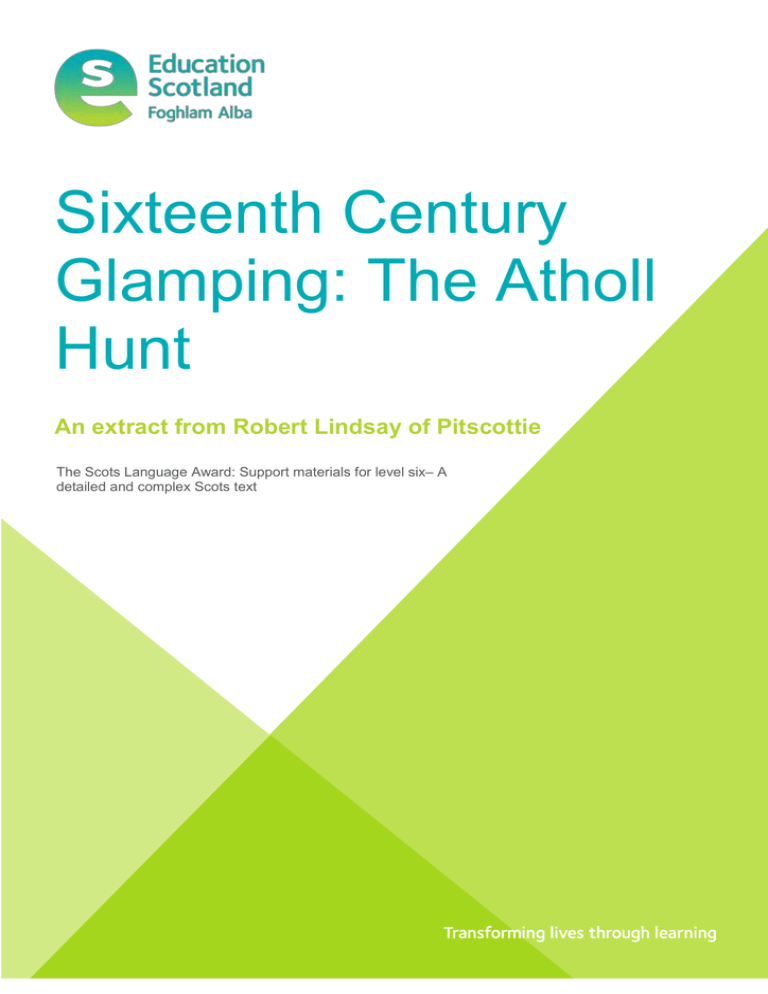
Sixteenth Century Glamping: The Atholl Hunt An extract from Robert Lindsay of Pitscottie The Scots Language Award: Support materials for level six– A detailed and complex Scots text Sixteenth Century Glamping: The Atholl Hunt An extract from Robert Lindsay of Pitscottie: The Historie and Croniclis of Scotland This resource explores Scots language from the sixteenth century – the kind of Scots that was used by Mary Queen of Scots, John Knox, and James VI, and which was spoken throughout Lowland Scotland at the time. In the extract, which is taken from The Historie and Croniclis of Scotland, Robert Lindsay describes how King James V travels with his mother and an ambassador of the Pope’s to what is now Highland Perthshire. The Duke of Atholl hears that they are coming, and builds a remarkable, lavish hunting lodge for them to stay in while they are in the Highlands. The text is rich, complex, and fascinating: And efter this the king remanit in the castell sum tymes mekill of the winter tyde. Syne the nixt sommer passit to the hieland to hunt in Atholl and tuik witht him his mother Margarit quen of Scottland and ane ambassadour of the paipis quho was in Scottland for the tyme. The Earle of Atholl heirand of the kingis coming maid ane great provisioun for him in all thingis necessar pertening to his estaitt as he had bene in his awin palice in Edinburgh. He wantit nothing ffor I hard say this nobill Earle of Atholl gart mak ane curieous palice to the king… quhilk was buildit in the midis of ane fair medow ane faire palice of greine tymmer wond witht birkis that were grein batht under and abone, quhilk wes fesnitt in foure quarteris and everie quarter and nuike thairof ane greit round as it had bene ane blockhouse quhilk was loftit and jestit the space of thrie house hight; the fluir laid witht greine cherittis with sprattis medwartis and flouris. Then no man knew quhairon he yeid bot as he had bene in ane gardin. Farder thair was twa great roundis in ilk side of the yeit and ane greit portcullis of trie falland doune the maner of ane barrace witht ane greit draw brege, and ane greit fowsie and strak of watter sextene foot deipe and XXX futte braid of watter and also this palice withtin was weill syllit and hung with fyne tapistrie and arrasis of silk, and sett and lightit with fine glassin wondowis in all airttis [so] that this palice was allis plesantlie decoirit witht all necessaris pertenand to ane prince as it had bene his awin palice royall at hame. Farder this earle gart mak sic provitioun ffor the king and his mother and that stranger the ambassadour that thai had all maner of meittis, drinkis, deliecattis that was to be gottin at that tyme in all Scottland either in burght or in land that might be gottin for money; that is to say, all kind of drink, as aill, beir, wyne, batht quhyte wyne and clairit, mallvesie musticat and allacant, inchethrist and accqquitie. Ffarder thair was of meittis, of breid quhyte bried maine breide and gingebreid, witht flesches, beif, mutton, lambes, cuning, cran, swan, wile guse, pertick and plever, duke, Brissil cok and powins together witht blak cok and murefoull and cappercallzes; and also the stankis that was round about the palice was sowmond full of all deliecat fisches, as sallmond, troutis and perches, pykis and eilis and all uther kind of deliecat fisches that could be gottin in fresche watteris was all redy to be prepairit for the bancat. Syne was thair proper stewartis and cuning baxteris and also excellent cuikis and potiseris witht confectiounis and drogis ffor thair desairitis. 2 | Sixteenth Century Glamping: The Atholl Hunt – an extract from Robert Lindsay of Pitscottie All thir thingis beand in order and prepairit as I have schawin, hallis, chameris and witht costlie beding, weschell and naiperie according for ane king, nathing deminischit of his ordour more nor he had bene at hame in his awin palice. The king remainit in this present wilderness at the huntting the space of thrie dayis and thrie nightis, and his companie as I have schawin to yow affoir. I hard men say that everie day was the Earle of Atholl in expensis ane thowsand pound. This ambassadour of the paipis seand this great bancat and triumph being maid in ane wilderness, quhair thair was not toune near be XX myle, thocht it ane great mervell that sic ane thing sould be in Scottland considerand that it was bot the erse of the warld be uther contries, thair sould be sic honestie and polliecie in it and spetiall in the hieland, quhair thair is bot wode and wildernes. Bot maist of all this ambassadour mervellit quhene the king depairtit and all his men tuike thair leif, the hieland men sett all this fair palice in ane fyre that the king and his ambassadouris might see thame. Then the ambassadour said to the king, “I mervell that ye should tholl yone fair palice to be brunt that your grace hes ben so weill ludgit into.” Than the king answerit that ambassadour and said, “it is the use of our hielandmen thocht thay be never so weill ludgit, to burne thair ludging quhene they depairt.” This being done, the king turnit to Dunkell that night and on the morne to St. Johnstoun. I hard say the king at that tyme in the boundis of Atholl and Stretherne, that is to say Benglow, Beneurne and Bencruine, betweix the hillis and in the boundis forsaidis slew XXX score of heartis and hyndis witht uther small beistis as re and rebuke, wolf and fox, and wyldcattis. Robert Lindsay of Pitscottie was a writer from Fife who was the author of a lengthy chronicle or history of Scotland. Lindsay’s chronicle is not completely trustworthy as historical source material, but it provides us with a very colourful window on Scotland’s past. Whether or not the remarkable summer palace described in this extract ever really existed, we will never know. While some believe that Lindsay of Pitscottie was inclined to exaggeration, it is difficult to think that the palace described here is just a product of the writer’s imagination. It is certainly well-known that the monarchs of Scotland travelled from their palaces in Edinburgh or Stirling to the Highlands for hunting, and the idea of building elaborate organic dwellings in the wilderness crops up elsewhere in Scottish Literature, such as in Robert Louis Stevenson’s famous novel Kidnapped. (Text reproduced by permission from The Smoky Smirr O Rain, Itchy Coo/Black and White Publishers, 2003.) 3 | Sixteenth Century Glamping: The Atholl Hunt – an extract from Robert Lindsay of Pitscottie Working with the text – understanding and vocabulary Interactive strategies are recommended for working through the following vocabulary, which must be learned in order to understand the text. Paired or group work where one partner has access to the vocabulary lists or dictionary and explains the meanings to the other partner/members of the group can be very effective. Connections to contemporary spoken Scots or English, and to knowledge of Scottish history and wildlife, will also help learners to interpret and understand the text. Careful study of these materials will enable deeper learning to take place, and will be more likely to result in successful achievement of the unit outcomes. This is a historical Scots text, and the materials have been devised so as to enable learners to develop their ability to demonstrate the outcomes and assessment standards from the History and Development Unit at Level 6, namely Analyse factors that have helped to shape the contemporary Scots Language by 1.1 identifying a range of factors which have helped to shape the contemporary Scots language; 1.2 explaining these factors in detail and depth; 1.3 reaching a reasoned conclusion about the impact of each factor on the contemporary Scots language. The materials will also help learners to develop their ability to Analyse Features of the contemporary Scots language by 2.1 identifying contemporary Scots words; 2.2 identifying words from other languages which are similar to these; 2.3 explaining in detail the relationship between Scots and the other languages which these similarities suggest; 2.4 explaining linguistic features of the Scots language; 2.5 identifying examples of these linguistic features to support the explanation. Crossover with English Because Scots and English are what are known as ‘sister’ languages, with a common ancestor in the Anglo-Saxon language, there are many words which are the same, or very similar, in Scots and English. In some of the following words from the extract, only the spellings are different. Others contain different sounds, but are very similar to English words: quen – queen; maid – made; curieous – curious; sommer – summer (the Scots here is the same as modern German); beding – bedding; mervell – marvel; myle – mile; fyre – fire; lugit – lodged (Scots ‘it’ ending for the past tense of the verb); depairt – depart; tyme – time; wyldcattis – wildcats (Scots ‘is’ ending for plural of noun) Spelling systems hadn’t been standardised when this text was written. Individual writers could spell words pretty much as they chose. This was easy for writers, but put more demand on readers. Seventeenth-century Scots words that are still in use On another level, the extract contains a range of older words that are still used in modern Scots: Efter – after; mekill – much; syne – then; hieland – highland; gart/gar – made/make (in the sense to compel); tymmer – timber (wood for building); fluir – floor; flouiris – flowers (flooers); ane – one/a (the indefinite article); airts – directions; mak – to make; meit/meittis – food/foods (all foods, not only meats); gottin – past tense of ‘got’ (the word gotten is sometimes considered ‘wrong’ in English, but is common in modern Scots, and in American English); affoir – before (afore); thocht – thought; tholl – to suffer, or to permit. 4 | Sixteenth Century Glamping: The Atholl Hunt – an extract from Robert Lindsay of Pitscottie Other vocabulary and features of Scots from the seventeenth century This list contains further words, phrases, and features of language which were used in Lindsay of Pitscottie’s time: remanit – remained (Scots ‘..it’ ending for past tense verb); winter tyde – winter season; quho – who (‘quh..’ is the older Scots equivalent to modern ‘wh..’); quhilk – which; quhairon – whereon; quhair – where; hierand – hearing (In older Scots the present participle ending is ‘..and’. This is why modern Scots present participles end in ‘in’ or ‘an’, e.g. ‘hearin’, ‘runnin’ etc.); yeid – went (similar to modern Scots gaed or geed); ilk – each; syllit – ceilinged; arrassis – tapestries/wall hangings; palice royall – royal palace (the word order is different in many older Scots texts, with adjectives often coming after the nouns they go with. These are known as postposed adjectives, and represent a link between Scots and French, and other European languages.); mallvesie, musticat and allicant, inchethrist and accqquitie – Malmsey, Muscatel, Alicante, Hippocras, Aqua Vitae (varieties of wines and spirits, mostly from continental Europe); sowmond – swimming; baxteris – bakers; potisers - pastry chefs; drogis – probably spices in this context; thir things beand – these things being; paip – the Pope; sic ane thing – such a thing; erse – arse; brunt – burnt; thocht – though; heartis and hyndis – harts and hinds (male and female large deer); re and rebuke – roe and roebuck (female and male small deer). Older Scots in names and place names Some of the Scots words used in the extract are no longer in common everyday use, but still exist as place names, or family names. The passage twice mentions the Hieland, or Hielandmen. In Glasgow, the section of Central Station which covers over a part of Argyll Street is still known as the Hielandman’s Umbrella. Birkis are birches, as in the Birks o Aberfeldy, while a nuike is a corner, as in the East Neuk o Fife. While we no longer call bakers baxters in Scotland, the common surname Baxter indicates that an ancestor of the person bearing the name was a baker. The online Dictionary of the Scots Language/ Dictionar o the Scots Leid is an excellent resource, and will help learners to find the meaning of any other vocabulary from the text. The DSL contains hundreds of references to the work of Lindsay of Pitscottie. If you scroll to the bottom of the page of definitions, it also gives details of the origins of Scots words. Search the dictionary for powins, stankis, cuning, cran or weschell: http://www.dsl.ac.uk/. 5 | Sixteenth Century Glamping: The Atholl Hunt – an extract from Robert Lindsay of Pitscottie Medieval Scottish Food “This earle gart mak sic provitioun ffor the king and his mother and that stranger the ambassador that thai had all maner of meittis, drinkis, deliecattis that was to be gottin at that tyme in all Scotland either in burght or in land that might be gottin for money.” Where would the foodstuffs listed by Pitscottie have come from in James V’s day? Where would we obtain the same things? Complete the following table, including as much detail as possible. Note to practitioners: You may wish to tailor the table below, removing as many answers as you wish in order to make it appropriate for your class. Printing on A3 will allow more space for learners to record their answers. 6 | Sixteenth Century Glamping: The Atholl Hunt – an extract from Robert Lindsay of Pitscottie Drinkis Drinks Where we would get it Aill Ale Supermarket or brewery shop Beir Beer Supermarket or brewery shop Brewer – barley grown locally Whyte wyne White wine Supermarket or off licence Clairit wyne Claret Mallvesie The wine Malmsey Supermarket or off licence Supermarket or off licence Musticat Muscatel Allacant Alicante Inchethrist Hippocras Accqquitie Aqua Vitae Imported from France, Germany, Italy or Spain Imported from Bordeaux Imported from the Mediterranean Imported from Spain Imported from Spain Made from imported wine and spices Possibly distilled locally Supermarket or off licence Supermarket or off licence Make your own Buy another spirit instead Where Atholl might have got it (including ingredients to make it) Brewer – barley grown locally Comments on foodstuff Comments on language A food as well as a drink as it was so full of nutrients Water was unsafe to drink so even children drank ‘small beer’ Meittis Not just meat, but all food, as in modern Scots Guhyte breid White bread Supermarket or baker Mane breid Almond bread Recipes on internet Gingebreid Gingerbread Supermarket or baker Beif Beef Muttun Mutton Lambes Lamb Cuning Rabbit Butcher or supermarket Butcher or supermarket Butcher or supermarket Butcher, fishmonger or supermarket; shot or snared Barley and wheat grown locally Almonds imported from Mediterranean Ginger imported from Africa Farmed locally Farmed locally Farmed locally Farmed locally; shot with arrows or snared 7 | Sixteenth Century Glamping: The Atholl Hunt – an extract from Robert Lindsay of Pitscottie Cran Crane or heron We don’t eat it Hunted/caught locally Swan Swan Hunted locally Wile guse Wild goose Pertrick Partridge Plever Plover We don’t eat it. Swans are protected by the Queen. Hunted/caught locally Some supermarkets We don’t eat it Duke Duck Brissill cok Turkey? Powins Peafowl Blak cok Murefoull Black grouse Red grouse – ‘moor fowl’ Cappercallzes Capercaillie Sallmond Salmon Troutis Birds would have been hunted with hawks, caught with sticky ‘bird lime’ or caught in nets Hunted locally Hunted locally Hunted locally Shot/supermarket Hunted locally or butcher Supermarket or Possibly butcher farmed locally or imported from Africa We don’t eat Hunted locally them much Shot; buy online Hunted locally Shot; buy online Hunted locally We don’t eat them; they’re endangered Supermarket, fishmonger or caught Hunted locally Trout Supermarket, fishmonger or caught Caught locally Perches Perch We don’t eat them much Caught locally Pykis Pyke We don’t eat them much Caught locally Eilis Eels Specialist suppliers Caught locally Caught locally Gathering their eggs is now illegal Guinea fowl were often called turkey People begin shooting them on 12 August, ‘The Glorious Twelfth’ Notice the ‘z’ – it is really the letter yough Now considered a delicacy; very cheap then Scots plural ‘is’ ending used where English uses same word as singular Fashions change – we have more varieties of fish to choose from so can be picky Can taste muddy if badly cooked Many are caught here and exported 8 | Sixteenth Century Glamping: The Atholl Hunt – an extract from Robert Lindsay of Pitscottie What do you make of the ‘delecattis’?: ‘Syne was thair proper stewartis and cuning baxteris and also excellent cuikis and potiseris witht confectiounis and drogis ffor thair desairitis’ Which of the other foodstuffs listed above would have counted as delicacies? Which would we class as such now? Suggested sources of information How to cook Medieval: http://www.godecookery.com/how2cook/how2cook.htm#top Medieval food – British Library: http://www.bl.uk/learning/langlit/booksforcooks/med/medievalfood.html Lifting the Lid – 400 years of food and drink in Scotland – The National Library of Scotland: http://www.nls.uk/exhibitions/food-and-drink 9 | Sixteenth Century Glamping: The Atholl Hunt – an extract from Robert Lindsay of Pitscottie Questions for discussion and possible answers Assessment standards referenced here are from the Understanding and Communicating Unit at Level 6: These questions will help learners to develop their ability to Understand, analyse and evaluate detailed and complex texts in Scots by 1.1 identifying and explaining the purpose of, and audience for, the text; 1.2 identifying the main ideas and supporting details of the text; 1.3 applying knowledge and understanding of Scots to explain the meaning and effect of the text. 1) What are the main topics and ideas covered in each paragraph of the text? (Note some specific details from each paragraph.) 2) Why, in your view, would Lindsay of Pitscottie have written this text? What readership do you think he had in mind as he wrote it? (You may wish to identify more than one purpose or audience.) 3) Describe in detail the reaction of the Pope’s ambassador to what he sees and experiences in the Scottish Highlands. 4) What does the text suggest about Scotland’s connections to Europe during the sixteenth century? In your answer you may wish to consider: the language and vocabulary of the text the fact that the ambassadour has made the journey to Scotland the range of foods and drinks offered to the guests how these foods and drinks might have been made available in this seemingly remote location 5) What is your reaction to the statement in the text that Scotland was sometimes considered to be “the erse of the warld be uther countries”? 10 | Sixteenth Century Glamping: The Atholl Hunt – an extract from Robert Lindsay of Pitscottie Some possible answers 1) The king travelling to the Highlands; the people who went with him Details of the palace constructed by the Duke of Atholl Details of the food and drink enjoyed by the guests How long the King stayed there; how much it cost the Duke The reactions of the Ambassador; the destruction of the palace Where King James V went afterwards; the animals he killed while hunting Plus some relevant details, translated into modern English. 2) Purpose: to inform; to record; to entertain; to impress; for reasons of national pride. Audience: Lindsay’s contemporaries; Lindsay’s descendants; people who came later in history; people with a low opinion of Scotland. 3) Surprise, astonishment, he is impressed (possibly because his expectations were low) 4) Postposed adjectives (palice royall) and continental names for drinks (musticat, allacant etc.) suggest linguistic affinity, communication and familiarity with Europe. The Scots word flouris is very similar to French fleurs - many Scots words are similar to French, as a result of the ancient affinity between Scotland and France, known as the Auld Alliance. Ambassador’s presence suggests Scotland was considered important/interesting enough for the Vatican to send a representative. Lavish range of luxury foods, including spices, wines and spirits, many of which could only have been imported. This suggests well-established trade connections with continental Europe. There must have been transport links – perhaps via places like Leith and Aberdour - across the North Sea to the European continent. 5) Answers will depend on the individual, but may reflect amusement, indignation, surprise. 11 | Sixteenth Century Glamping: The Atholl Hunt – an extract from Robert Lindsay of Pitscottie Ideas for writing Assessment standards referenced here are from the Understanding and Communicating Unit at Level 6: The following tasks will help learners to Create and produce detailed and complex communication in Scots for a specific purpose and audience by 2.1 selecting a method of communication that is appropriate to the purpose and audience; 2.2 selecting detailed and complex ideas and content for the communication; 2.3 using a format and structure that is appropriate to the method of communication, purpose and audience; 2.4 applying detailed knowledge and understanding of Scots to communicate meaning. Option One: Write a parody or pastiche of Lindsay of Pitscottie’s piece in modern Scots for Hiya Magazine (a yet-to-be published, imaginary Scots version of Hello). You may use your own variety of Scots for this task if you wish. Option Two: Write the Pope’s Ambassador’s blog, in Scots, on his trip to Scotland. Or you could write a series of tweets or Facebook posts. (The Ambassadour would have made every effort to learn the language to impress his hosts, and wants to show off his new skills.) For this option, you should emulate the Older Scots of the text, and incorporate some of the features of Older Scots. Option Three: Design the Visit Scotland campaign which micht hae been written tae persuade ither countries tae visit ‘the erse o the warld’. Use modern Scots or Older Scots. Option Four: Using the internet and your library, explore some of the following ideas: Wolves and wyldcattis; the current ‘rewilding’ campaign in the UK; the Highlands in the Middle Ages; the status of the Scottish wildcat; monarchs and hunting; the Caledonian Forest; where and when the last wolf was killed in Scotland; the reintroduction of wolves to the Yellowstone National Park in the United States; search for references to wolves written in Scots language appearing in the statutes (laws) of the medieval Scottish Parliament http://www.rps.ac.uk/static/statutes_index.html. Now, write discursively or argumentatively - in Scots - on the topic of rewilding in general, or specifically on the idea of the reintroduction of the wolf to Scotland. 12 | Sixteenth Century Glamping: The Atholl Hunt – an extract from Robert Lindsay of Pitscottie Education Scotland Denholm House Almondvale Business Park Almondvale Way Livingston EH54 6GA T +44 (0)141 282 5000 E enquiries@educationscotland.gov.uk www.educationscotland.gov.uk
